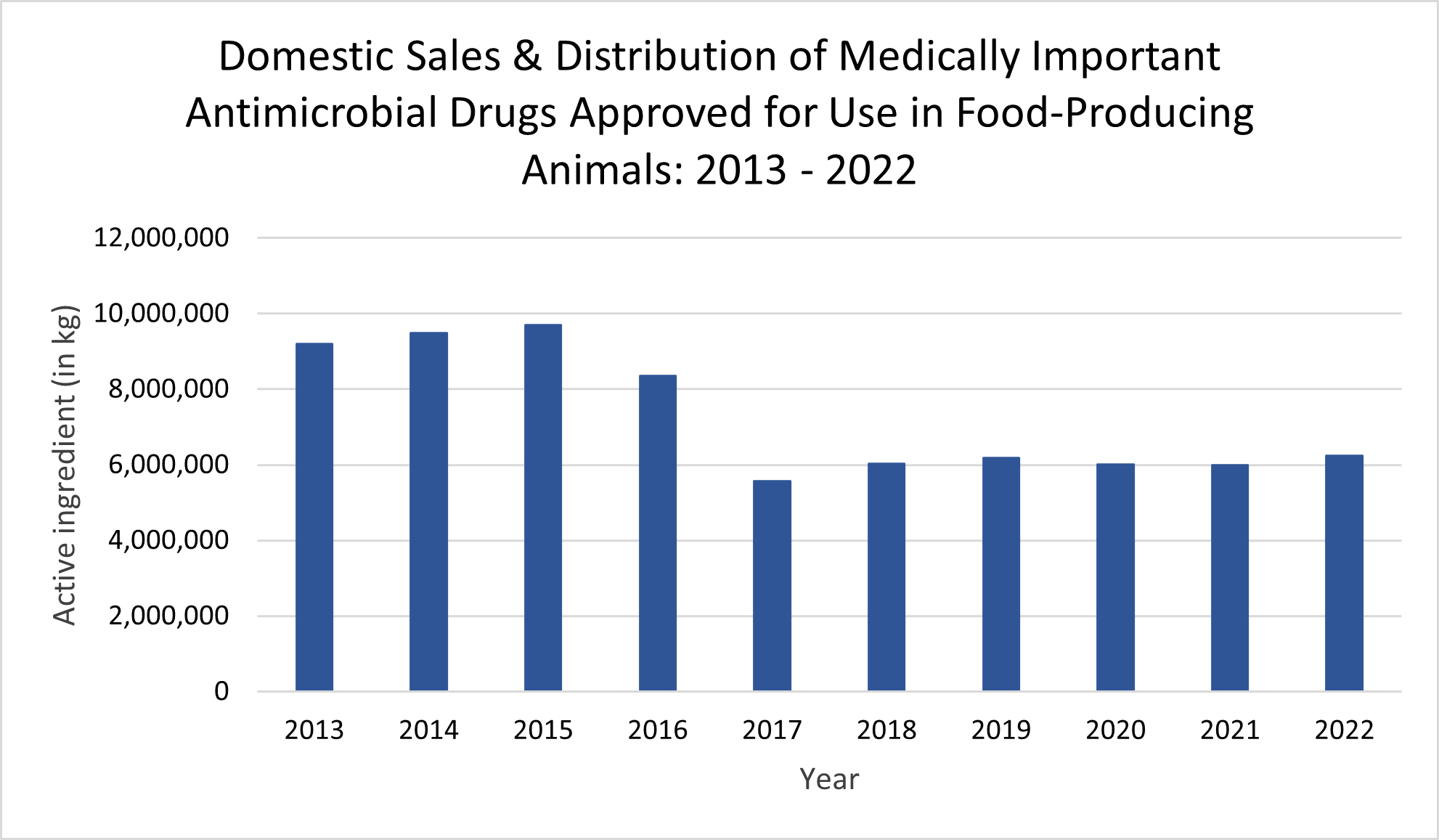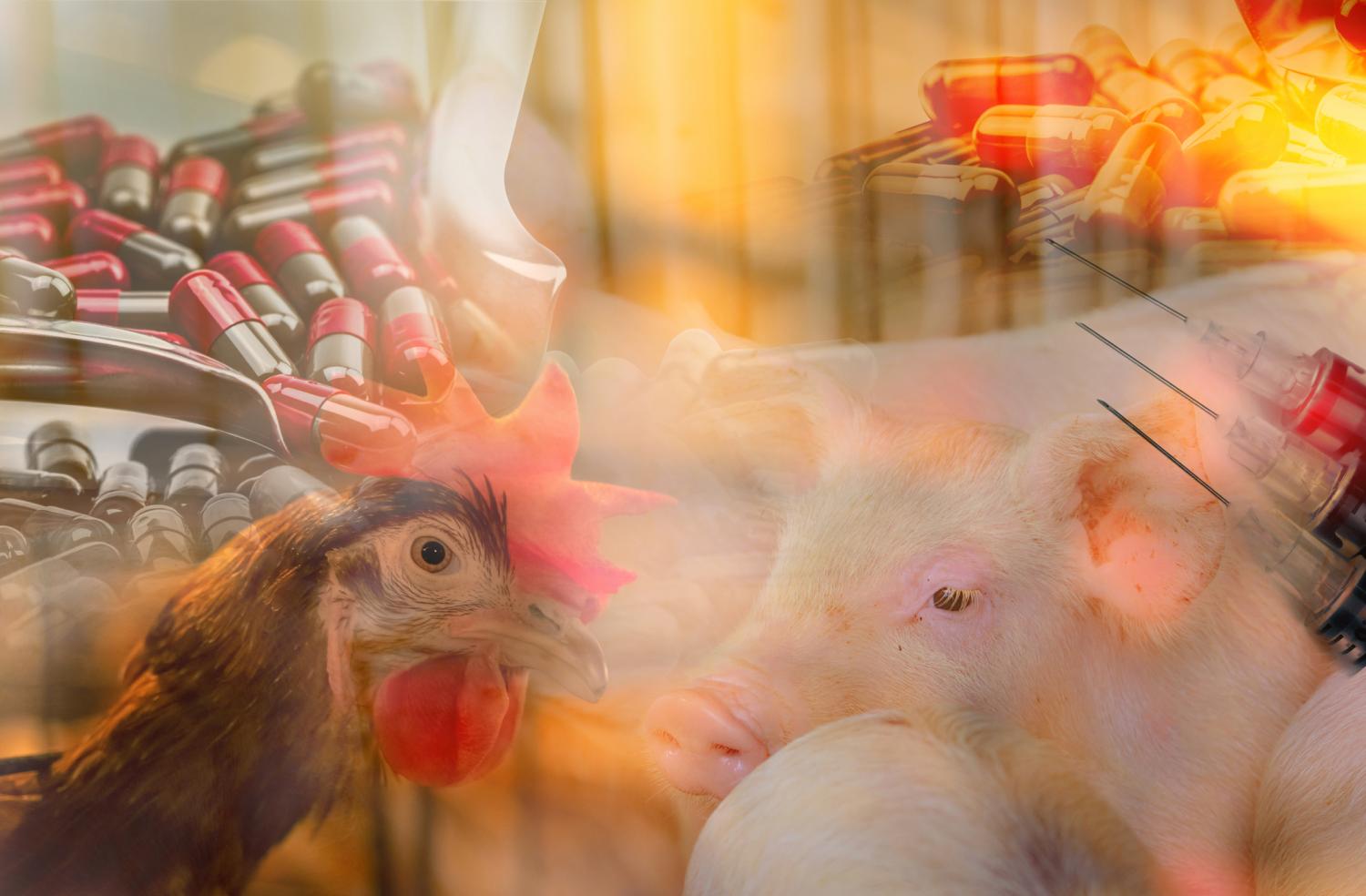New data released yesterday by the US Food and Drug Administration (FDA) show that sales of medically important antibiotics for use in food-producing animals rose by 4% last year.
The latest summary report from the FDA's Center for Veterinary Medicine shows 6.2 million kilograms (kg) of medically important antibiotics were sold and distributed for use in livestock (chicken, turkey, cattle, swine, etc) in 2022, up from 5.9 million kg in 2021. Medically important antibiotics, which are tracked because they're also used in human medicine, accounted for 56% of all antibiotics sold for used in food-producing animals.
The FDA notes that, since 2015 (the peak year of animal antibiotic sales), the volume of antibiotics sold for livestock and poultry in the United States has dropped by 36%. But all of the decline in sales occurred in 2016 and 2017, the year that new FDA rules ending the use of medically important antibiotics for growth promotion went into effect.

Since 2017, antibiotic sales have steadily risen—a trend that advocates for better antibiotic stewardship in food-animal production say indicates the FDA isn't doing enough to ensure more judicious antibiotic use on farms.
"For every year of the FDA's 2018 5-year stewardship plan, sales have gone up, not down [compared with 2017]," David Wallinga, MD, a senior health officer with the Natural Resources Defense Council (NRDC), told CIDRAP News. "By any measure, that's a complete failure."
Increase in biomass-adjusted sales
As in previous years, swine accounted for the highest percentage of medically important antibiotic sales (43%), followed by cattle (41%), turkey (12%), chicken (2%), and other food animals (2%). While fewer medically important antibiotics were sold for chicken in 2022, more were sold for cattle (a 4.4% increase), swine (5%), and turkey (10%).
"It's disappointing that [antibiotic] use is gradually creeping up again in all animals except chicken," said Gail Hansen, DVM, MPH, a public health and veterinary consultant. "There doesn’t seem to be an interest in preserving the effectiveness of antibiotics for animals and people by working on methods to decrease the need for antibiotics."
Almost two thirds of all medically important antibiotics sold for food-animal production were tetracyclines (65%), with penicillins accounting for 10% of sales, macrolides 9%, aminoglycosides 6%, sulfonamides 5%, lincosamides 3%, and fluoroquinolones and cephalosporins each accounting for less than 1%. Nearly all drug classes saw sales increases in 2022, led by lincosamides (an 11% increase).
The 2022 FDA report also includes, for the first time, biomass-adjusted sales data, which adjusts raw annual antibiotic sales data to account for the total mass (the estimated population multiplied by the average weight) of each animal species potentially receiving those drugs. Animal biomass adjustment helps contextualize antibiotic sales data by accounting for the size and composition of animal populations, which can change from year to year. The European Union (EU) and Canada have been using biomass-adjusted sales data for several years.
There doesn’t seem to be an interest in preserving the effectiveness of antibiotics for animals and people by working on methods to decrease the need for antibiotics.
According to the biomass-adjusted sales chart in the new report, all antibiotic classes except for fluoroquinolones saw increases in biomass-adjusted sales from 2021 to 2022, and most of them saw double-digit increases.
"It really shows that more antibiotics are being used," Hansen said.
The FDA says sales data provide only part of the picture of medically important antibiotic use on farms.
"Sales volume observed over time can be a valuable indicator of market trends related to these products," the agency said in a news release. "However, when evaluating the progress of ongoing antimicrobial stewardship in veterinary settings, it is important [to] consider additional information sources including actual use data, animal demographics, animal health data, and data on antimicrobial resistance."
But Wallinga said the increase in biomass-adjusted sales shows the intensity of medically important antibiotic use in food-animal production is rising, and that stewardship efforts are failing.
"It means antibiotics are being used less wisely, less judiciously, and with greater harm to public health," Wallinga said.
Larger declines in other countries
The concern about overuse of medically important antibiotics in food-producing animals is that it contributes to a reservoir of resistant bacteria that could reduce the effectiveness of those antibiotics, both in animals and humans. While using antibiotics to treat animals with bacterial infections is necessary for the health and welfare of the animals, antibiotics are also used in animal feed and water to prevent disease, a practice critics say is inappropriate.
Both Wallinga and Hansen noted that the trajectory of antibiotic use on US farms stands in contrast to other countries that have seen sharp declines in the use of medically important antibiotics in livestock and poultry. Hansen says those countries have been successful in part because they've set targets for reducing veterinary antibiotic use—something the FDA has been reluctant to do.
"It's being done in other places and doing being done successfully," she said. "So I'm not sure why it's impossible to do here."
One example is the United Kingdom, where figures released by the UK Veterinary Medicines Directorate in November showed that sales of antibiotics for use in food-producing animals fell by 9% from 2021 to 2022 and have declined by 59% since 2014. Wallinga and his NRDC colleagues also released a report earlier this year showing that intensity of antibiotic use on European farms fell much more dramatically than on US farms from 2011 to 2020.
"The US is really an outlier here, in terms of antibiotic use going up," Wallinga said.
























